Transport yourself to the enchanting world of Shirakawa-go (白川郷), a UNESCO World Heritage site steeped in history. We’ll take you on a journey to the picturesque village, where we uncover the secrets behind the breathtaking thatched roofs and the Gassho-Zukuri (prayer-hand construction) houses.

Have you ever marveled at images capturing the charm of Japanese villages blanketed in snow, seemingly plucked from the pages of an ancient folktale? It was a dream come true when my family made a trip to Shirakawa-go (白川郷), a UNESCO World Heritage site, to witness the timeless beauty of the otherworldly farmhouses. Nestled in the Japanese Alps, Shirakawa-go is a sought-after haven for global travelers and a cherished gem for locals in Japan alike.
![By Tsuda from Tsushima, Aichi, Japan (Flickr) [CC BY-SA 2.0], via Wikimedia Commons](https://www.justonecookbook.com/wp-content/uploads/2023/11/Shirakawa-go-Travel-Guide-33-001.jpg)
This is part of our Takayama travel guide series. If you haven’t had a chance to read them, please start with part 1 to catch up with our adventures!
Table of Contents
Access to Shirakawa-go
The trip from Takayama to Shirakawa-go is just a short 1-hour bus ride via the Tokai Hokuriku Expressway. On our journey from Takayama, we enjoyed scenic views of the Japanese countryside, passed by a Hida Beef farm, and traversed numerous long tunnels, including Japan’s second-longest tunnel.
If you are coming from Kanazawa, you can ride the Nohi Bus (2,600 yen one-way in 2023) from Kanazawa Station West Exit Platform 4, which takes around one hour and 15 minutes. From Toyama Station, you can ride the same bus (2,400 yen one-way in 2023), which will take approximately one hour and 20 minutes.
If you are coming from Tokyo, Osaka, or Kyoto, we recommend traveling to one of the cities mentioned above and then taking the appropriate bus.

When is the Best Time to Visit Shirakawa-go
We chose to travel at the end of June to enjoy the summer scenery. However, arguably, the best time to visit is during the winter season, from December to March, when you can experience the snowy landscapes. Additionally, in January and February, you can partake in light-up events and winter illuminations. Another great time to go is between September and November, as the village glows in vibrant autumn foliage.
If your aim is to see cherry blossoms, we would not recommend Shirakawa-go, as there aren’t too many cherry blossom trees.
Exploring Shirakawa-go: Japan’s Folktale-like Village
Upon our arrival at Shirakawa-go, the bus took us to the observation deck at the top of the hill, where a viewpoint welcomed us with stunning views of the village. After reveling the beauty of the landscape, the bus descended toward the village.
(see the map of the village)

Once the bus arrived at the parking lot, we crossed the Shokawa River on a suspension bridge to step into the magical Shirakawa-go.
Enveloped in a mountainous region surrounded by forests, the air around is so clean, and the crystal-clear river beneath the bridge adds to the tranquil ambiance, a stark contrast to Tokyo and Yokohama.
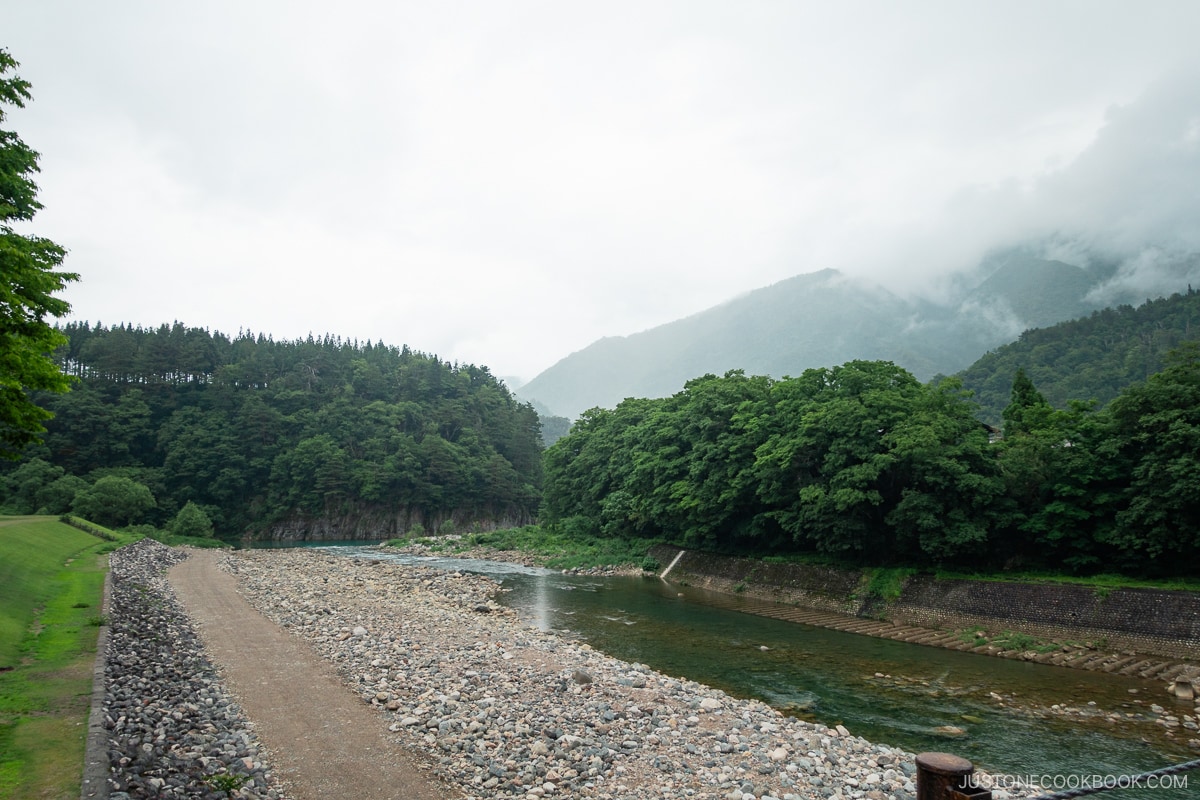
Gassho-Zukuri Houses in Shirakawa-go
What makes Shirakawa-go unique and special? It’s the collection of gassho-zukuri (合掌造り) roofs atop the houses in the village! You’re probably wondering about the meaning of gassho-zukuri.
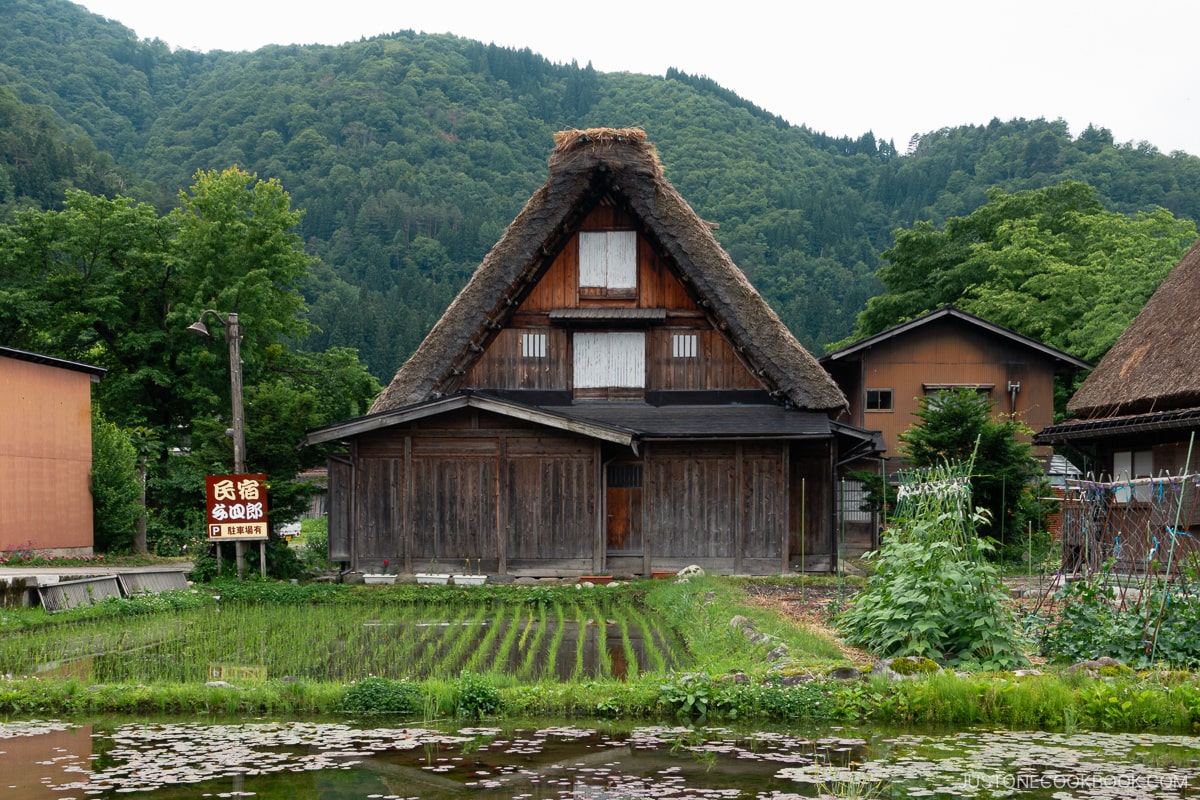
Gassho refers to the shape of the hands in a praying position with the palms facing each other (prayer-hands construction).
This one-of-a-kind thatched roof design is not only beautiful but also highly functional, capable of withstanding the weight of heavy snowfall during the winter. The steeply angled roofs shed the snow easily while creating a spacious interior for various purposes during the harsh winter months, such as the traditional industry of silkworm farming.
Our guide informed us that the roofs last about 20-30 years, but replacement is both expensive and labor-intensive. Each side of the roof costs about USD 100k, and replacing both sides would incur a $200k expense. Apart from the cost, approximately 150 workers are required to construct a new roof, as you’ll see in a picture later.

There are a total of 114 thatched-roof buildings in Shirakawa-go. Among them, you may notice that some of the houses in the village have a modern roof. Why?
It’s because some of the roofs were changed before the UNESCO recognition in 1995. Now, the Japanese government prohibits owners from changing their thatched roof to a modern one.
Myozenji Temple Museum
As you stroll through the village, you’ll come across Myozenji Temple Museum (明善寺郷土館). The temple, built about 230 years ago, features the famous thatched roof that we recommend checking out.

Kanda House Tour
One thing you will notice right away is that these Gassho houses are surprisingly big. Contrary to expectations, they are quite tall, with multiple levels and an incredibly spacious interior.
Among the Gassho houses open for tours, our guide recommends the Kanda House (神田家). During our visit, the Kanda family still resided in the house but in a separate wing. Here, they serve wild herb tea to their guests during the visit, creating a pleasant pit stop along your Shirakawa-go travels. The entrance fee is 400 yen (as of 2023).

The Kanda house was built by Wada Yaemon (the 2nd son of Wada House), who later changed his name to Kanda. The structure was built over 10 years around 1800 AD. In addition to raising silkworms, the Kanda family business also manufactured gunpowder.
Upon entering the house, we paid Mr. Kanda the entrance fee, which granted us access to freely explore the building.
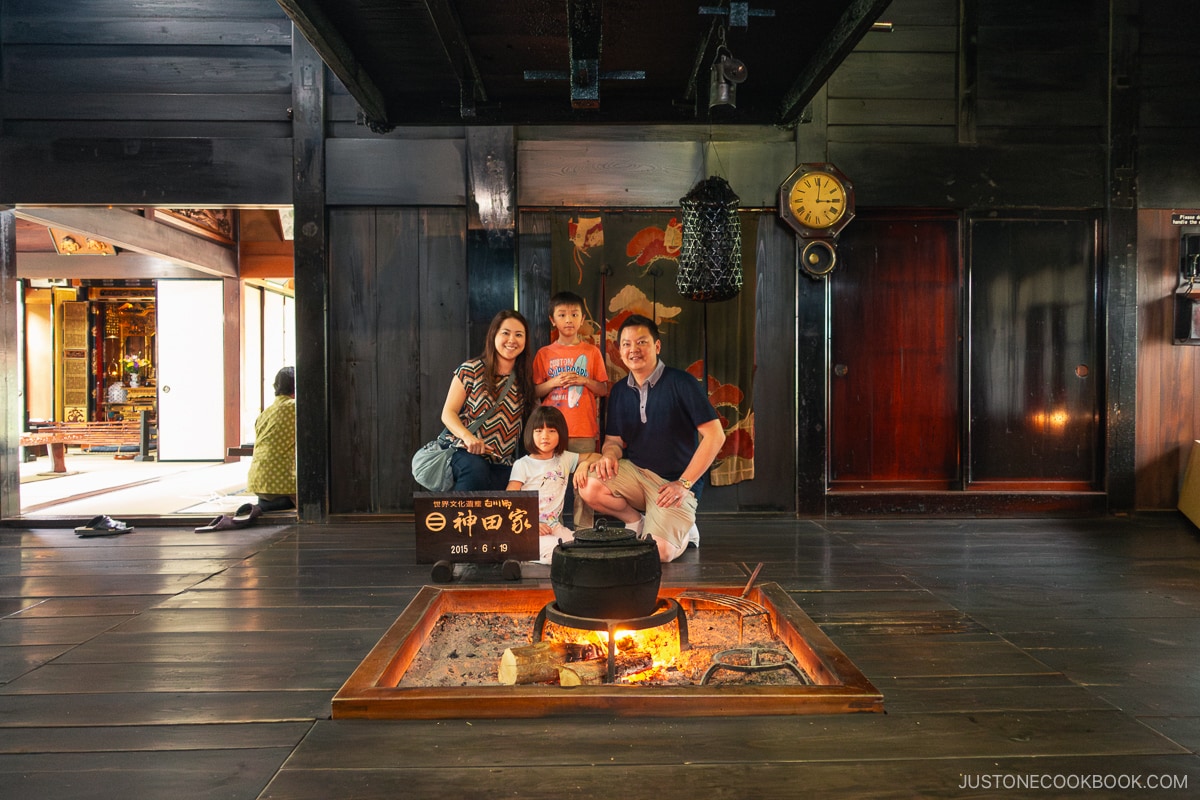
Kanda House – First Floor
The first floor is a large open space (family room) with a live fire and hearth in the middle of the room. Connected to the family room are guest rooms, bedrooms, rooms for Buddhist monks, and an altar.
Here is our son waving to us from the “fire watch” window below. As the entire house is made out of wood, this small window allows monitoring of the fireplace from the second floor. There are also fire hydrants all over the town to make sure these national treasures are safely protected from fire.
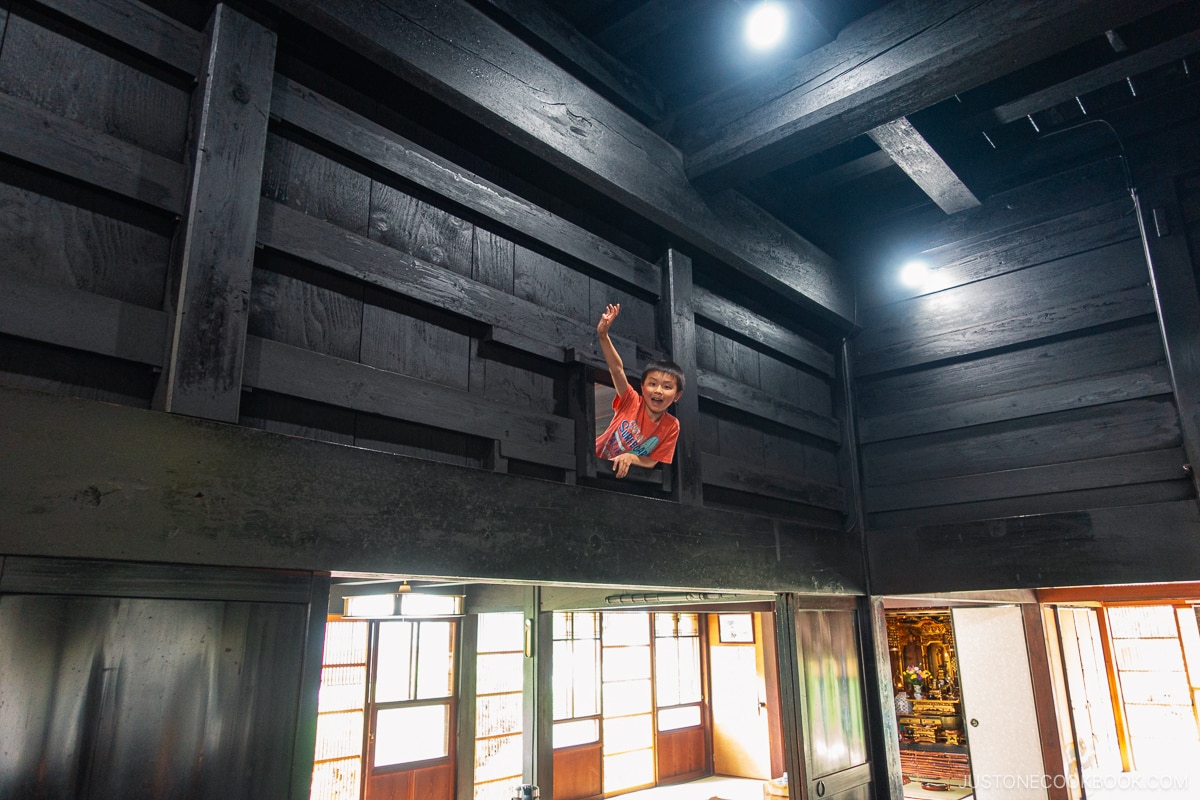
Each room and corner of the Kanda house showcased a variety of artifacts, offering glimpses into both business and home life.
Kanda House – Second Floor
Moving to the second floor, we found equipment used for working in the snow as well as for making sake.

Here is the section where they explained the secret behind the strength of the gassho-style roof, which can withstand strong wind and snow.

There was a picture taken of the Kanda house when it was having its roof re-thatched. In the photo, you can see the large number of people required to work together for the job. Can you guess how many? It was 184 people!

Kanda House – Third Floor
Reaching the third floor, the width of the room becomes significantly narrower, though still plenty of space to walk upright.

Here we saw the equipment for making silk, including pans for raising silkworms, a silk weaving machine, and a silk spinster.

Kanda House – Top Floor
Lastly, on the very top floor, you can see the underside of the roof. One interesting note: as there is a fire burning on the first floor, it gets very smoky as you go higher in the building. Your clothes will likely smell of smoke after the tour!

Are you surprised by how large the interior space was? The house has no columns taking up space in the middle of the structure.
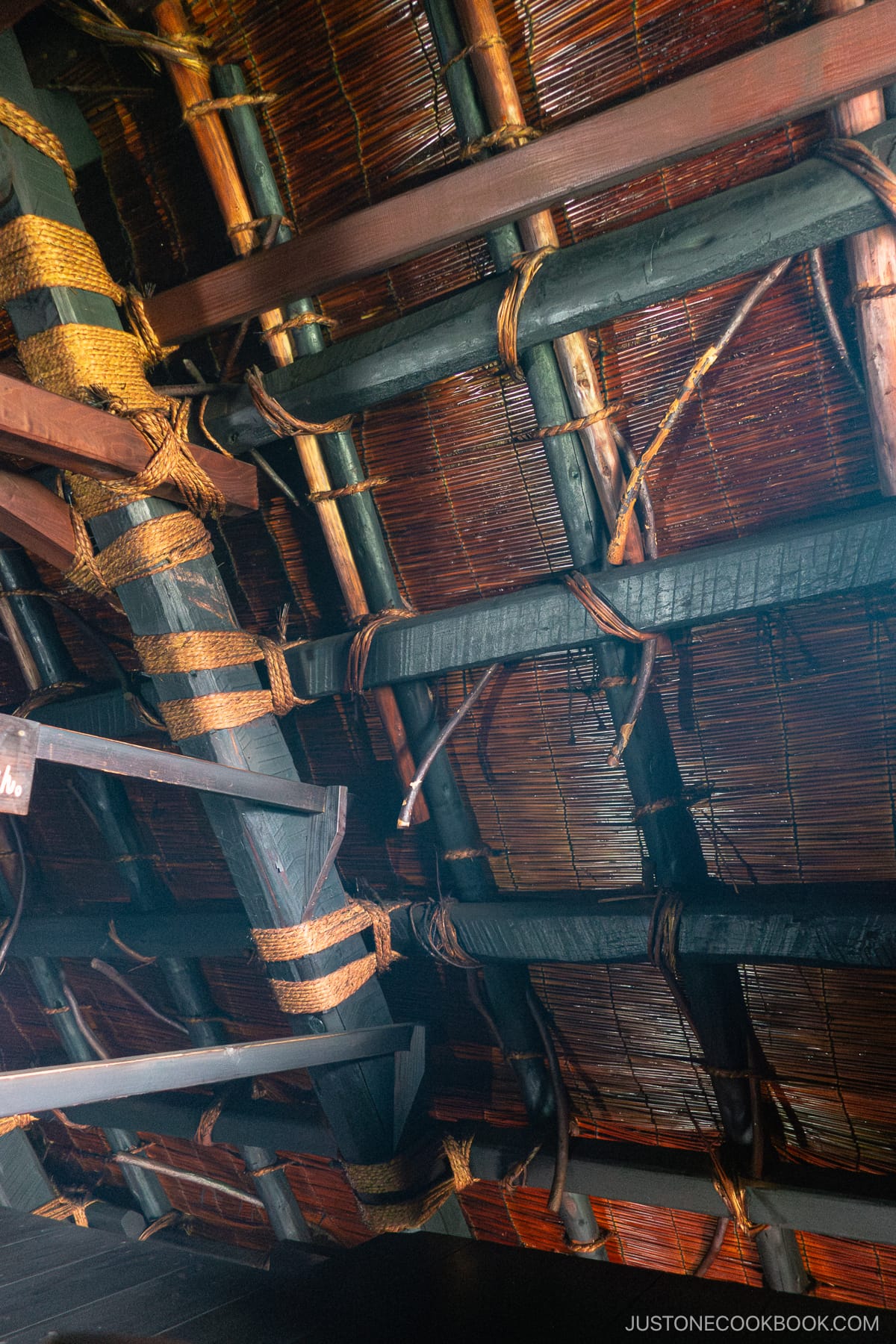
Besides the Kanda House, other well-known Gassho houses include the Nagase House and Wada House. Wada house is the largest Gassho-style house (picture below).

Shirakawa-go Village
Strolling through the village, you’ll come across various restaurants, cafes, souvenir shops, and craft stores. These establishments offer sake, Hida Beef Korokke (croquette), and Kushiyaki (skewers).


During our walk on the main road (while it was sprinkling), we noticed some trout in the river raised by local farmers, adding to the village’s charm.



If you wish to extend your experience in this ethereal village, you can stay overnight at some of these houses that have been converted to Minshuku (Japanese Bed & Breakfast 民宿).
Staying in Shirakawa-go
The Minshuku below is Koemon (幸ヱ門), which was built during the Edo Period, offering a super-traditional Japanese experience. Just note that the guest rooms do not have their private baths or toilets so you will need to share with others. 😉

We hope you enjoyed visiting Takayama with us. We had a wonderful three days there and highly recommend it if you want to experience a different side of Japan from Tokyo and other large cities.
If you haven’t read my travel posts about our one week in Hokuriku 北陸地方(the north-western part of Japan) including Kanazawa, Toyama, Kurobe Gorge, Tateyama Alpine Route, and Takayama, please start reading from this post.









Thank you for your travel guide! Always would love to return to Japan for a nice place like this to bring back our marriage memories beginning there (on Hokkaido) 57 years ago!
I’ve enjoyed reading all of your travel blogs. I especially enjoyed your travel blog about Takayama and Shirakawa-go. It is on my bucket list of places to visit,
Hi Elizabeth,
Thank you for your kind comments and stopping by to read our travel adventures. Do plan ahead as the area gets a lot of snow in the winter time.
Cheers
Amazing construction, quite beautiful, and seems very strong, as well. It looks like all of the timbers are held by joints, and some kind of fabric ties? Did you find out what materials? It also seems that such construction would be quite robust against earhquake? Sadly, I was nearby, stayed at White Bone Onsen, visited Kurobe dam, but did not know of this village! Thank you for sharing this with us!
Hi Barry! Ah so sorry you were close but couldn’t visit there. I don’t remember the material that was used to tie the joints… but it wasn’t fabric, it was like a rope material (natural product). It’s beautifully made, and so many people are required to work together to put up the roof. Thank you for reading this post!
Hi, I just discovered your website 🙂 We are going to Shirakawago in 3 weeks! Do you know if 2 hours enough to explore? and in a slow pace as we have a small child with us? 🙂
Welcome to my blog, Shelly! Hmmm 2 hours with a small child. Let me think… I think I’d say 2-3 hours, especially if you go all the way there. You’ll be visiting at least 1 house, and shops etc. 2 hours exact might be too tight as you have to walk around (not in one place). Hope this helps. Have a great trip to Japan!
Hi Nami, partly inspired by your blog posts we are heading to Takayama this October and now planning some details on what to do. We are staying 2 nights (2.5 days, leaving midday on 3rd day back to Tokyo), how are you able to fit so many activities? Are most attractions open early? Did you arrive super early on day one? Looking forward to Shirakawago, however we may take the Nouhi bus for time flexibility.
Hi Neko! How exciting! We really loved visiting Takayama and I hope you will too! We arrived in Takayama around lunch time. Hope you have a great trip there!
Wonderful pictures !!. I visited this place in April, 16. Zukuri huts are amazing to see and whole village is very charming. When I visited I could see Mt Fuji clearly. It was a great day. check my experience on this post.
http://www.ultrawidelife.com/historic-village-of-shirakawa-go/
Thanks Ankur! Wow, you take beautiful pictures! Thank you so much for sharing your post link here! 🙂
Hi Nami, I visited this beautiful village in 2013. This place is so charming and magical especially during winter time. I arrived there in the afternoon therefore I didn’t manage to visit those museums and temple you mentioned in your blog. But lucky me I spent a night in one of the house and I absolutely love the experience, especially the Hida beef. Here’s the blog post of my visit to Shirakawago – http://whenshetravelstheworld.blogspot.sg/2013/12/japans-golden-route-tour-of-world.html
Hi Iva! Thank you so much for sharing your travel post! SO pretty! I definitely love the look of snowy Shirakawago more than summer time (different beauty, of course). So happy to hear you enjoyed the trip. It’s such an unique experience!
Wow, amazing …wonderful place to visit someday.
Thank you Junna! This is such a beautiful place. If I didn’t mind cold weather, I would love to visit winter time. Such a beautiful place!!!
Hi, i would love to visit during winter time ‘coz you know i live in the hottest place in the world right now (Abu Dhabi,UAE ) during summer time temperature reached 50 degree Celsius, that’s why i love to visit winter time = ).
50C!!!!!!!!!!!!! I thought Japanese summer (around 30-33C) is unbearable. 😀 Must be nice to experience the real winter in Shirakawago. 🙂
Yes it is, i thought too summer in my home country (Philippines) is unbearable, when i came here in (UAE), oh i still love summer in Philippines hehe, it is really nice to experience real winter there, i hope we can visit, and i told my cousin about Shirakawago she said she never been there and i share your blog to her, she likes it. = ).
Hi Junna! Oh yeah, different hotness! 😀 You must miss the summer in Philippines along with all the foods and summer events.
Hope you get to visit Shirakawago. 🙂
I love your posts about this side of Japan, because when I visited I only saw Tokyo and tourist-y spots! Your children are so cute, that photo of your daughter is very sweet.
I’ll be posting my own travel blogs about my Tokyo trip on my blog soon.
http://www.busyforlife.wordpress.com
Hi,
Is there any restaurants around Shirakawa-go or to buy food for lunch if we do not join the tour?
Hi Vivien! Yes, there are restaurants there! Sorry I didn’t mention. Our tour started at 1 pm, so we had lunch in Takayama before getting on the bus. The tour is either start from the morning (I think it was 8 or 9… forgot) or afternoon (1 pm). You might not need to eat lunch there IF you use this tour. But it’s free time there, so you can stop by a shop/restaurant to eat. 🙂
This is where I got engaged in the fall of 2011! I love this town. 🙂
Hi Lesya! Aww! What a wonderful place to get engaged at! And it’s almost 4 year anniversary! Congratulations! 🙂
Love that first photo, it looks like a diorama
Dear Nami!
I saw the picture of this village on Instagram and hadn’t had a chance until today to read your post. Thank you for sharing with all of us, your readers and followers of this great blog!
What a beautiful place… I’ve not been to Japan yet and when I go one day, this will be on my list!
xo, Debra